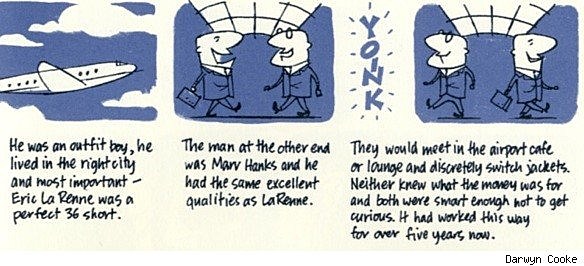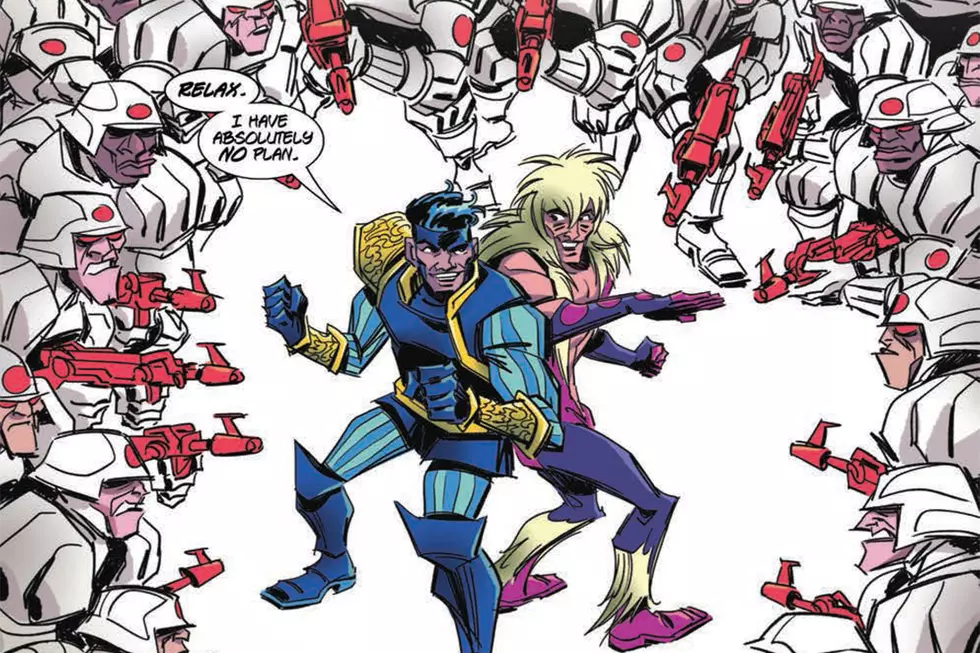
Digital ComicsAlliance: Darwyn Cooke and the Man Called ‘Parker’

Recently, Chris Ryall, Publisher and Editor-in-Chief of IDW Publishing, announced the 2012 return of Darwyn Cooke's adaptation of Richard Stark's Parker novels. The latest entry in the series is The Score, a tale of what happens when a group of men sit down and figure out how to rob an entire town blind. The novel is just as thrilling as it sounds, with a number of twists and innovative scenes, and I expect Cooke's adaptation of the work to be just as good.
This week on Digital ComicsAlliance, we're going to take a look at Cooke's work, Parker himself, and what makes these adaptations so great.

Cooke and Stark (the pseudonym the late Donald Westlake used when writing about Parker and his world) are both fond of describing Parker not as a super-criminal, but as more of a man with a job that he is dedicated to. A plumber, for example, or a carpenter. Parker goes into a heist with a role, and his only concern is filling that role so that he can get paid at the end of the job.
Since the authors approach Parker as a man with a career, rather than a flashy hood, he tends to come off fairly unadorned and basic, but never generic. Parker isn't one for brooding or interminable monologues. He's very plain-spoken, quick to explain what he wants, and efficient. He's an easy character to wrap your head around, and despite his cold demeanor, very easy to relate to in certain ways. We all know the pain of having a relatively simple job interrupted or ruined by those who are less professional or skilled than us. Parker often works with that idea, but in a criminal context.

I'd add another wrinkle to the idea that Parker is just a guy trying to do his job: He's a guy who is very, very good at his job. Parker isn't some fly by night hustler or cheap cat burglar. He's a thief, and more than that, he's muscle. He's the guy you go to when you need to convince someone that fighting back would be not just a terrible idea, but a fatal one. He's the guy with the cold eyes who stops bravery dead in its tracks. He's the one guy you should never, ever cross... and yet, some people still do. He isn't eager to hurt someone, and he doesn't enjoy violence, but there are times when it is simply necessary, for one reason or another. It's a side effect of the job.
Cooke's first entry into the Parker franchise was with Parker: The Hunter, which may be the most popular of Westlake's Parker novels as it has been adapted to film twice. I'm very fond of the "Straight-Up Cut" of Payback. It featured Mel Gibson as Porter, rather than Parker, and was a worthy re-edit of a botched theatrical release. Parker also appeared in Point Blank, played by Lee Marvin as "Walker." This '60s classic is fairly different from the original story, but still more than worth a watch.

Cooke, however, kept the Parker name and stayed true to The Hunter in his graphic novel adaptation. Other than a very short sequence or two, Cooke let the original text speak for itself. Rather than loading the book down with caption boxes, he simply shows the action and lets us fill in the blanks. Stark didn't make a habit of getting into Parker's head, and Cooke doesn't, either. We come to understand Parker by his actions, whether they are smooth, as in the way he effortlessly acquires cash and a new identity, or ugly, which is just one way to describe how he tears through the people that wronged him.
Parker: The Hunter is first and foremost a revenge tale, a story of what happens when you screw the wrong man, but it's also a Darwyn Cooke showcase. His art style is perfectly suited to the source material, and by making it a period piece, Cooke actually shows how timeless a good story is. We're looking at a story set in 1962, but it never feels dated or old. Instead, it feels classic. The '60s we most commonly hear about tend to involve flower children and Vietnam. The '60s of Parker: The Hunter are the other half of the '60s, a time period when men wore suits as a matter of course and fedoras weren't yet an ironic affectation. Parker's New York City is simultaneously gritty and stylish, depending on what angle you're looking from, and never anything less than familiar.

Save for three pages, the first 20-or-so pages of Parker: The Hunter are silent. There are words on the page on occasion -- signposts, driver's licenses, and checks all have some sort of writing on them--but they aren't explanations or dialogue. They're part of the art, something to establish the location, rather than to explain what's going on on the page.

Cooke's art is more than sufficient for that. The opening of Parker: The Hunter is as clean an intro to a comic book as you'll ever see. The very first page does a great job of establishing who Parker is; the next page shows us where he works (the gutters of the big city, in this case at least); and the third shows how society sees him. A woman in a car alternates between being enthralled and frightened of Parker, and he moves through the crowds of people in NYC like a shark. They make way when he strides through.
Parker: The Hunter was a straightforward comic book. Cooke gets in, does the story justice, and gets out. He doesn't go crazy with the layouts, or lean on any of the magic tricks that are specific to comics, not really. He just perfectly executes his craft on every single page. Parker: The Hunter is full of fantastic storytelling, whether in terms of panel-to-panel action or the way he transitions from scene to scene or moment to moment.

If Parker: The Hunter was the lure, then Parker: The Outfit is the hook. A sly combination of two novels from the Parker series (The Man With The Getaway Face, in which Parker visits a plastic surgeon, and The Outfit), Parker: The Outfit immediately gets down to business. On the very first page, a caption says, "When the woman screamed, Parker awoke and rolled off the bed." We see a picture of the woman screaming, and an empty half of the bed right at the moment after a bullet hits the pillow. It's clear where Parker was and where he went. The sheets are even still in motion. The next couple of pages show how he takes down the gunman (with a thrown gun, of all things) and then we're off to the races.

Parker: The Outfit is a revenge tale, too, but it unfolds differently from Parker: The Hunter. We see how Parker got his new face and we watch a quick heist out in north Jersey. We meet the cast of characters. Parker robs a poker game. And then, Parker writes a few letters to a few friends with sticky fingers and Parker: The Outfit is in full swing.
Rather than playing the one man army role again, Parker's enlisted a bit of help. He's met a lot of thieves in his time, and he's tasked those thieves with hitting the Outfit as hard as they can, just as a show of force.

(Chief among those friends, to me at least, is Alan Grofeld, an actor who finances his little neighborhood theater with gains from heists, and a thief who has a bit of fun when he's robbing people blind by playing the swashbuckling rogue. If I had to suggest any one reason to pick up this book, it would be so that you could experience the glory of Grofeld.)

The heists are where Parker: The Outfit goes wild. Stark's strength was always the methodical and detailed way he set up the caper. He'd explain the technology and techniques Parker and his crew used in such a way that it seemed down to Earth and perfectly normal. Rather than clutter up the page with a bunch of caption boxes, Cooke took a different route. Book Three features several different storytelling styles. Cooke inserts an excerpt from the original novel (featuring a byline by one "Richard Stark) into his comic book as part of "The Lowdown," a magazine all about true crime. Monopoly-inspired panels show the rise and fall of an Outfit boss. Some panels resemble instruction manuals. Others involve charts.

That's not all, either. Cooke explodes the simple explanations of how a few heists go down into something that's frankly incredible. He switches up his style, he experiments with his storytelling, and the result is that this is the part of the book that will hook you for life. He built up our trust with the straightforward storytelling in Parker: The Hunter and the first half of Parker: The Outfit. As a result, when he pulls us into all-new territory in the rest of the book, you're hooked. You don't even really have a say in the matter, near as I can tell--you made it this far, expecting one thing, and Cooke gave you another, and it's just as good. Why wouldn't you follow him to the ends of the Earth?
Parker: The Outfit never stops being an artistic milestone. Even after switching back to his usual style, Cooke varies the storytelling, drawing our eye to significant details by perfect panel construction or layout. It's the type of book you read to get better at reading comics, in addition to just being an incredibly fun tear through the criminal underworld.
Parker's a guy who's just good at his job. As it turns out, Cooke is pretty good at his, too.
If you're curious about the original novels, University of Chicago Press has an ambitious and well-designed set of reprints available in both print and eBook formats. I'd suggest reading both Stark's novels and Cooke's comic books. They're different enough that they are rewarding reads in their own way, and knowledge of the novels will undeniably enhance your appreciation of Cooke's comics.
Digital reading list:
-Parker: The Hunter
-Parker: The Outfit
More From ComicsAlliance


![Everything We Can’t Wait To See At San Diego Comic Con, Part Two: Saturday & Sunday [SDCC 2016]](http://townsquare.media/site/622/files/2016/07/SDCC-Sat1.jpg?w=980&q=75)





![‘The Twilight Children’ #4 Concludes Hernandez and Cooke’s Sci Fi Saga [Exclusive Preview]](http://townsquare.media/site/622/files/2016/01/twilight_featured.png?w=980&q=75)
